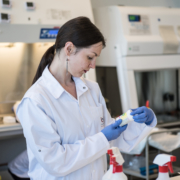What makes a synbiotic? ISAPP provides a sneak peek at the forthcoming international scientific consensus definition
By Kristina Campbell, science and medical writer
The word ‘synbiotic’ is found on the labels of many different products, from supplements to chocolate bars, and it has generally been understood to be a combination of a probiotic and a prebiotic. But what happens when scientists want to test whether these combination products really deliver any health benefits? Can these products be tailored to have specific effects on the body or on the human gut microbiota? Agreeing on a clear definition of synbiotics is needed to provide focus for scientific research in this area, to facilitate the design of studies, and to allow for progress wherein their health effects are uncovered.
The scientific definition of synbiotic was the central topic of the international scientific panel brought together by ISAPP in May 2019 in Antwerp, Belgium. Members of the panel, eleven of the top academic experts in the field of probiotics and prebiotics, gathered to clarify a scientifically valid approach for use of the word ‘synbiotic’, and to communicate this by position paper. The outcome of this consensus panel is currently in press at Nature Reviews Gastroenterology & Hepatology.
Kelly Swanson, Professor in the Department of Animal Sciences and Division of Nutritional Sciences at University of Illinois at Urbana-Champaign, chaired the panel and led the paper’s publication. Swanson has been studying gastrointestinal health in both humans, companion animals (dogs and cats) and rodent models for the past 20 years—and having followed the rapid advances in the field of probiotics and prebiotics during those two decades, he knew the task of creating a synbiotic definition would not be easy.
He says, “The field is highly complicated, so an interdisciplinary panel was essential. The main areas of expertise included microbiology and microbial ecology; gastrointestinal physiology; immunology; food science; nutritional biochemistry and host metabolism.”
A timely discussion
According to Swanson, an increase in research interest, built on a foundation of recent scientific and technical gains, made this the right time to come to consensus on a synbiotic definition. He says, “Over the past decade, technological advances have allowed scientists to study the gut microbiome at a molecular level. In addition to characterizing the composition of the gut microbes, researchers are learning more about their biological activity and how they may impact host health.”
Furthermore, clarity about the definition was urgently needed because of the rapidly growing synbiotics market. Consumers seem to be more aware of synbiotics than ever, but they face a bewildering array of product offerings labeled as ‘synbiotic’ without a clear understanding of what that term entails and with no framework for establishing scientific efficacy. Swanson says, “As the field has moved forward and the sales of probiotics and prebiotics have increased, there has been more interest in combining substances to enhance efficacy. Some of these combinations may function as synbiotics, but it is not guaranteed. Rather than randomly combining substances together, there should be scientific rationale supporting their use.”
Clarifying the concept
One of the first questions the panel members had to tackle was whether to stick to the idea of a synbiotic as ‘probiotic plus prebiotic’, thus leaning heavily on the ISAPP-led international consensus definitions of probiotics and prebiotics published in 2014 and 2017, respectively. But the panel members decided this narrow scope would ultimately limit innovation in the synbiotic category.
Swanson explains, “While many synbiotics may be composed of an established prebiotic and established probiotic, the panel did not want to restrict scientific advances in the synbiotic category by requiring use of components already established on their own.”
As a result, he says, previously untested live microbes and potential prebiotic substances could be considered a synbiotic if the combination showed efficacy, and if the health benefit came from administering both the live microbe and the substrate it utilized—that is, the microbe together with its ‘food’.
Another conclusion from the panel is that probiotics (with known health benefits) and prebiotics (with known health benefits) cannot be called synbiotics unless they have been tested together. “There should be a rationale supporting the combination used, and then testing of the combination to confirm its efficacy,” says Swanson.
The panel suggests a synbiotic may be composed of either of the following, as long as efficacy is demonstrated for the combination:
- Established probiotic + established prebiotic (each component meeting the efficacy and mechanistic criteria for each)
- Previously untested live microbe + a substrate that is selectively utilized by the co-administered live microbe
Further details, including two different ‘categories’ of synbiotics, will be provided in the published paper.
In addition to the definition, the publication will cover the history of synbiotic-type products, how these products can be characterized, levels of evidence that currently exist versus levels of evidence desired, points about safety documentation and reporting, and relevant characteristics of the target hosts.
A remaining challenge—not just for the expert group, but also across the field—is the difficulty of establishing causal links between substances’ effects on the gut microbiota (e.g. ‘selective utilization’ of a substrate) and health outcomes.
While the publication of the synbiotic definition will be an important milestone, Swanson anticipates further discussion in the years ahead. “As more is learned, I expect the criteria for assessing synbiotic efficacy will continue to change,” he says.
An update on the scientific consensus definition of synbiotic was presented to ISAPP members at the 2020 virtual meeting in June.





